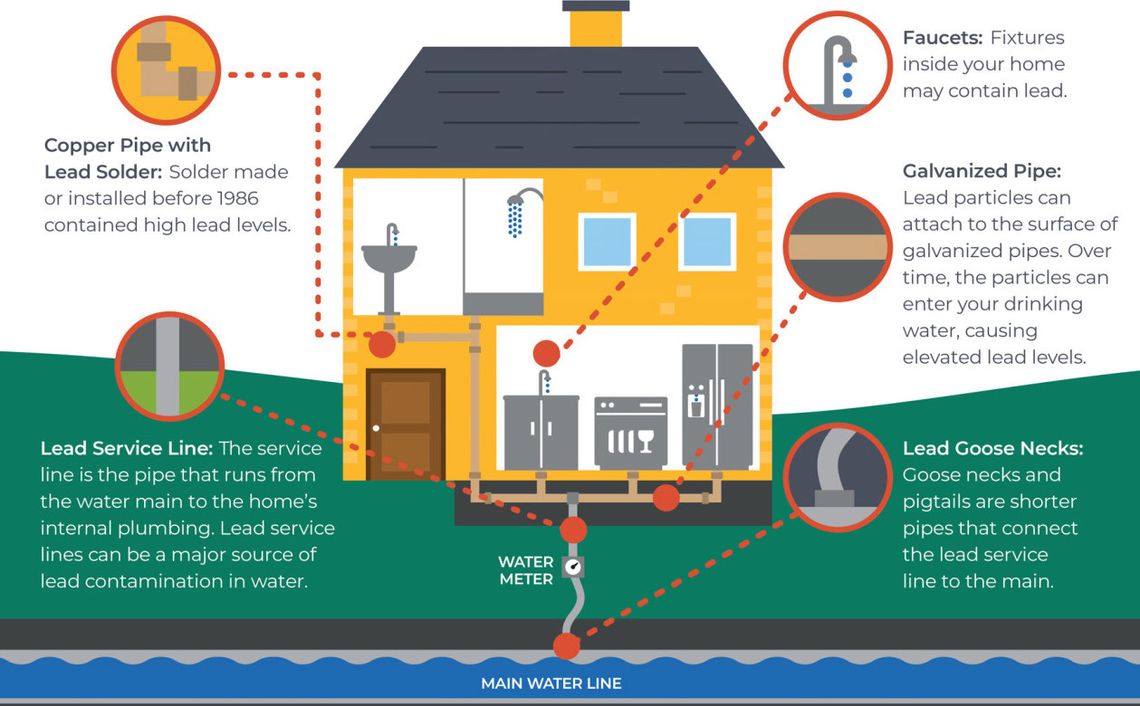Lead pipe service water lines must be replaced over the next 10 years according to new rule
The United States Environmental Protection Agency (EPA) finalized a new lead and copper rule improvement plan (LCRI) mandating that all drinking water systems in homes and commercial properties need to not only identify lead water service lines, but also replace such lead-based water lines within the next 10 years.
What does this mean for residents and business owners in Clay County? It’s time to start working on addressing these types of water lines according to the EPA’s announcement issued in early October.
Copper and plastic service lines are not included as part of this mandate, but the EPA’s LCRI does require municipalities to regularly inform families and businesses of the possibility of lead or galvanized contaminants from their water service line, the potential health effects, and steps to reduce exposure.
If you are planning to replace a leadbased service line, it is highly encouraged to reach out to your local city or village office so that each municipality can update their respective records on-file for each residential, commercial or business in each respective community in the Clay County News coverage area.
This newly-adopted mandate is not a mandate by any local or county government entity, it is a sole mandate handed down by the U.S. EPA.
HEALTH EFFECTS OF LEAD EXPOSURE
Exposure to lead in drinking water can cause serious health effects in all age groups. Infants and children can have decreases in IQ and attention span. Lead exposure can lead to new learning and behavior problems or worsen existing learning and behavior problems.
The children of women who are exposed to lead before or during pregnancy can have increased risk of these negative health effects. Adults can have increased risks of heart disease, high blood pressure, and kidney, or nervous system problems.
SOURCES OF LEAD IN DRINKINGWATER
The EPA estimates that 10-20 percent of a person’s potential exposure to lead may come from drinking water. Infants who consume mostly formula mixed with lead-containing water can receive 40 to 60 percent of their exposure to lead from drinking water.
The main sources of lead exposure are lead-based paint, lead-contaminated dust or soil, and some plumbing materials. When water is in contact for several hours with pipes (or service lines) or plumbing that contains lead, the lead may enter drinking water.
Homes built before 1988 are more likely to have plumbing containing lead as Nebraska instituted a lead ban on July 1st, 1988, mandating all pipe, pipe fittings, solder, and flux installed by any public water systems be lead-free.
STEPSTO REDUCE EXPOSURE • Run your water to flush out lead. If the tap hasn’t been used for several hours, run water for 15-30 seconds to flush lead from interior plumbing or until it becomes cold or reaches a steady temperature; • Use cold water for cooking and preparing baby formula. Lead dissolves more easily into hot water. Do not use water from the hot water tap to cook, drink, or make baby formula;
• Do not boil your drinking water. Boiling water will not remove lead from water;
• Clean your aerator. Regularly remove and clean your faucet’s screen (also known as an aerator). Sediment and debris including lead particles from lead service lines can collect in your aerator and dissolve back into your drinking water;
• Filtration. Using a filtration system can reduce lead in drinking water if it is certified to remove lead. Filters must be properly installed, maintained, and replaced to ensure they remain effective at removing lead. For more information on home water filtrations system, visit EPA’s website at https://www.epa.gov/ water-research/consumer-tool-identifying- point-use-and-pitcher-filters-certified- reduce-lead; and
• Use alternative sources of water. You may want to consider using bottled water or an in-home water dispenser.
REPLACING LEAD SERVICE LINES In many cases, the city or village municipalities own the water service mains and connections up to and including the curb stop.
The property owner owns and is responsible for the service line from the curb stop to the residence or business.
If a property owner of a lead based service line from the curb stop into the residence or business are planning on replacing your portion of the service line, it is strongly encouraged that you contact your local city or village office to inform them of the replacement process.
Additionally, as a reminder, Nebraska811 must be notified of any projects that require excavation or disturbing of the soil.
A request for utility locating must be made at least two, but no more than 10 days prior to the start of excavation.
Location requests can be made by going to www.ne1call.com, or calling 811 or 800331-5666.
For more information about reducing lead exposure and the health effects of lead, visit EPA’s website at http://www. epa.gov/lead



